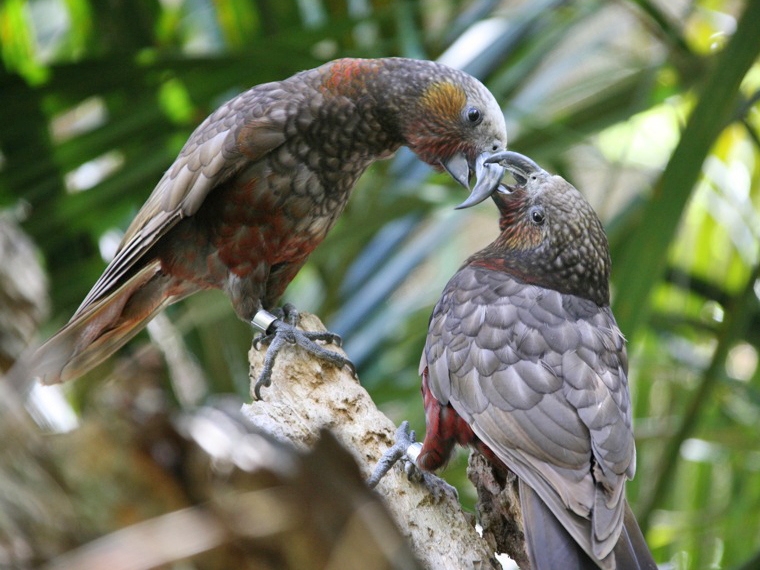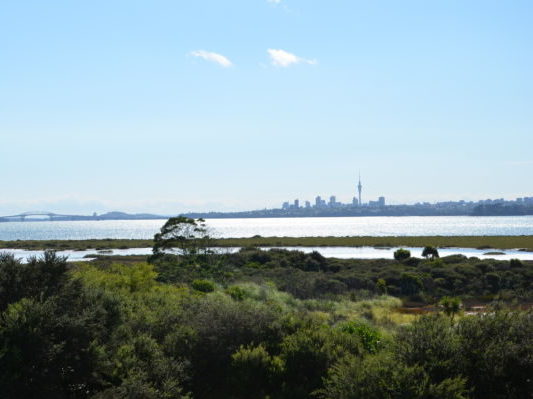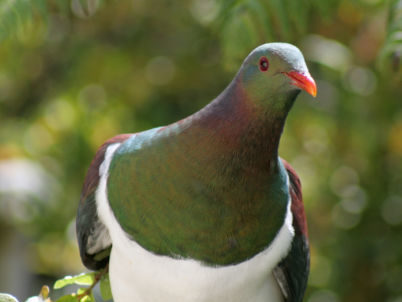Suburban gardens, city parks, reserves and thoughtfully planted urban spaces can mean that our cities are surprisingly diverse in plants and habitats. But so far reintroductions of native species have been restricted to islands, fenced sanctuaries and remote habitats.
If there’s a sanctuary close to your suburb, like Zealandia for example, you may reap the rewards of natural spillover from the flying species, but what about wildlife that can’t ‘fly the fence’? Native frogs and lizards in your rockery? Giant weta in the woodshed? Kiwi fossicking in your compost bin perhaps?

Maybe it wouldn’t be quite as ‘impossible’ as you think…
Two scientists from the Zoology Department at Otago University, Yolanda van Heezik and Philip Seddon asked 18 experts from across New Zealand what species might be potential candidates and what might be the benefits, opportunities, challenges, and requirements for the reintroduction of native species into New Zealand’s urban areas. The results of their survey are published in Pacific Conservation Biology.

“In this paper we review reasons for considering reintroductions into human-dominated landscapes and discuss the few examples of urban reintroductions. We then present the results of an expert knowledge elicitation exercise on appropriate urban reintroduction candidates, restorations considered to be socially acceptable that would support reintroductions and limiting factors that would need to be addressed.”
The first question is why reintroduce species into urban spaces when there is a whole lot of ‘wild’ waiting well beyond the urban boundaries?
“Despite these challenges, and the highly modified and often severely degraded state of most urban habitats, there are compelling reasons for protecting and enhancing populations of animals in cities. Possibly the most powerful argument is our own well being, as mounting evidence exists for a strong link between exposure to nature and physical, psychological and spiritual well being in children and adults of all ages. However, while significant public health gains could be achieved through greater contact with nature, the ongoing process of urbanisation of human populations, rapidly expanding cities, changing values and attitudes, and limited opportunities to engage with nature have all conspired to produce a generation of people who increasingly have little daily contact with nature, with the result that they become disconnected from nature and disinterested in pro-environmental behaviour.”
So it would be good for us – and ultimately good for conservation, in that more people would care if they actually saw/experienced/enjoyed the native wildlife they are being asked to protect. But there’s more to it than that. Cities in New Zealand and around the world are already home to some endangered wildlife. While not perfect, urban habitats may well be more diverse than agricultural land with its large expanses of monoculture grassland and crops.
“Besides enhancing human well being, biodiversity in ever-expanding cities has the potential to play an increasingly important role in contributing to regional biodiversity, as is recognised by the Convention on Biological Diversity. In their analysis of urban bird and plant diversity across 54 and 110 cities respectively, Aronson et al. (2014) found 36 birds and 65 plants identified by the IUCN Global Red List as threatened with extinction, with threatened bird species occurring in 14 cities.”
It’s happening naturally to some extent already – but how much better might we make it.
“Although cities support regional biodiversity and native species, worldwide they contain substantially lower densities of species compared with non-urban habitats, indicating scope for better design and management of urban habitats and urban animal populations. Urban reintroduction is a strategy that could enhance diversity. We consider both the factors likely to limit reintroduction success in urban areas in New Zealand, and the social acceptability of addressing such limiting factors.”
The authors consulted experts from Landcare Research, Universities, Zealandia, Auckland Zoo, Department of Conservation, a local government and an environmental consultancy to explore the challenges and come up with a ‘pick list’ of species that might be suitable. They received 18 responses.
The specific survey questions were:
1. What native New Zealand species do you think could be good candidates to consider for urban reintroductions?
2. What might be socially acceptable (even community-led) restorations to facilitate such reintroductions?
3. What are the limiting factors/unknowns that would need to be addressed
“Of the 80 suggestions and the 41 species or species-groups (e.g. bats, beetles, large invertebrates) proposed by respondents as potential reintroduction candidates, 54% were forest birds, 21% were invertebrates (weta, large snails, slugs, beetles, peripatus), and 12% were lizards. Wetland birds were mentioned seven times, tuatara (Sphenodon punctatus) three times, bats, Hochstetter’s frog (Leiopelma hochstetteri) and fish twice, and little penguins (Eudyptula minor) and exotic species once.”
Potential reintroduction candidates needed to meet several criteria to be considered suitable for a successful urban reintroduction.
“General features identified by respondents as indicative of reintroduction suitability were most commonly tolerance to predation, i.e. able to persist in conditions of low predator densities (e.g. invertebrates, some passerines and lizards; although behavioural flexibility, particularly with respect to habitat selection, was mentioned by three experts. Other features included high reproductive rates, iconic status, local extirpation, or persistence with decline; the latter would indicate some degree of resilience to human modification and disturbance, and include species that are extant in mainland areas subject to variable levels of predation by introduced mammals as well as species that might be present already in some urban areas but not others (e.g. bellbirds persist in urban Dunedin, but are absent from other urban areas).”
Some key considerations were also identified.
“Key considerations were improved understanding of the causes of the original extirpation from the area and identification of current limiting factors or barriers to recolonisation. Barriers to natural recolonisation of suitable urban areas, such as those formed by roads or other infrastructure or unsuitable landscapes or land management regimes, could be overcome through translocation. However, existing threats within an urban reintroduction site would need to be addressed so as not to create sink populations. Supplementary food could be provided in the event of unexpected and temporary resource shortages.”
A predator free – or at least predator controlled environment would also be a key factor.
“Creation and maintenance of a low-predator environment seems a prerequisite for almost any reintroduction candidate, and success might be more likely if reintroduced species are ones for which refugia can be created. The specific predators that would need to be controlled vary with the species being translocated, e.g. kiwi could persist with rats present, but could not sustain predation by dogs.”
What do we need to do to make it happen. Socially acceptable and community led changes that would be necessary were also considered.
“The 55 different interventions thought to be acceptable by communities fell into five main categories:

1. the creation of habitat (revegetation, ponds, wetlands; riparian plantings), provision of resources through planting appropriate species (including bird feeders) and refugia through plantings, construction of rock piles, placement of artificial cover objects for lizards and bug hotels;
2. predator control; including control of possums, hedgehogs, stoats, rats, mice and cats and dogs, pet-free subdivisions, cat curfews, and bylaws to control cat and dog access;
3. nest boxes;
4. monitoring;
5. weeding.
Social acceptability was considered to be the key to urban reintroduction success.
“Many of the requirements for restorations to be successful are social: the inclusion of families and communities, provision of opportunities for social connections, relevance to everyday life, targeting of local issues, promotion of collective action, fostering roles of local stakeholders, and promoting direct experiences with nature. These requirements can often be met through habitat restoration. Restoration of habitat was most frequently deemed by the experts to be a socially acceptable means of facilitating reintroductions, with some emphasising that improving habitat quality is the most powerful tool for truly increasing urban biodiversity.”
Another important point made in the article, is that the biggest gains may come from better valuing what we already have.
“Reintroduction can play a role in enhancing biodiversity but its contribution will ultimately be less than what can be gained through protecting and restoring what is already there, and, by doing so, facilitating recolonisation. An example suggested is the reintroductions of forest birds in Wellington, which appear to have been successful because of the green belt in the city and connections to larger, relatively intact habitats that had retained a suite of species that were already there. However, those species that do not require a lot of space and are less able to disperse across barriers such as roads (e.g. flightless invertebrates such as Peripatus, and some skinks), may require translocation to facilitate establishment.”
Predation was a key limiting factor identified by the 18 experts surveyed.
“Social acceptance of restorations that involve killing animals can be more difficult to obtain than those involving planting, monitoring, or weeding. However, predator control has been adopted by many New Zealand community groups as a means to create an environment that can support the species they would like to see. All but five respondents felt that cats and dogs, in particular, pose a significant barrier to the success of urban reintroductions and, to a lesser extent, other predators, probably because control of species such as rats and possums was seen to have greater social acceptability.”
So what chance of one day spotting a kiwi over the back fence? It may depend on ‘social licence’ and how much we’re prepared to change our own ways.
“The control of pet cats and dogs requires social licence that is currently largely absent. While kiwi could probably thrive in town belts and bush fragments and around the edges of cities, dogs would be a major problem. However, when a community is fully engaged in a restoration, such as in Polhill Reserve, Crofton Downs and the Miramar Peninsula in Wellington, then reintroduction of kiwi could be considered.”
The full article is published in Pacific Conservation Biology. Only the abstract is freely available to non-subscribers.

